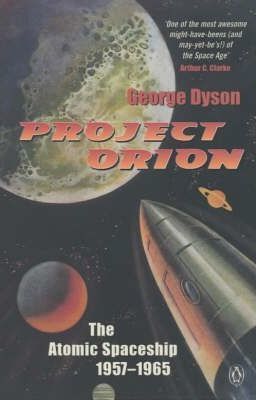Project Orion: The Atomic Spaceship 1957-1965
Like cheap, shiny space suits and bug-eyed rubber monsters, nuclear-powered spaceships today seem like little more than laughably naïve 1950s science fiction tropes. It might have been otherwise--and still could be. George Dyson, son of supergenius physicist Freeman Dyson, wrote Project Orion to share some of his father's amazing research with the world. Much had been kept secret for years, but Dyson's unique insider status permits great depth and breadth on this important tale.
Conceived in the wake of Sputnik, Project Orion was a true vision of '50s engineering: a huge 40-person ship powered by hundreds of tiny atomic bombs, capable of much greater lift and efficiency than chemically driven rockets. Struggles between NASA, the military, Congress, and other parties doomed Orion, but Dyson has gathered hundreds of documents and interviewed most of the researchers and engineers who worked together, trying to reach "Saturn by 1970."
His knack for storytelling makes the book a quick, delightful read; even the staunchest anti-nuke activist has to admit that lighting a cigarette off a parabolic mirror facing a bomb test is pretty cool. By the end of the 20th century, technology had caught up with the vision of Orion--it's considered one of our best bets for long-distance space transit. Whether or not that could ever happen politically, Project Orion is a compelling exploration of scientific imagination.
*Slight moisture damage to bottom of some pages.*| Author | George Dyson |
|---|---|
| Publisher | Penguin Books |
| Place | London |
| Year | 2003-03-26 |
| ISBN | 9780140277326 |
| Binding | Paperback |
| Condition | Fair |
| Comments | Slight moisture damage to bottom of some pages. |
How we describe the condition of our books
We are very proud of the condition of the books we sell (please read our testimonials to find out more!)
New: Exactly as it says.
As New: Pretty much new but shows small signs of having been read; inside it will be clean without any inscriptions or stamps; might contain a remainder mark.
Very Good: Might have some creases on the spine; no hard cracks; maybe slight forward lean and short inscription inside; perhaps very minor bumping on the corners of the book; inside clean but the page edges might be slightly yellowed.
Good: A few creases on the spine, perhaps a forward lean, bumping on corners or shelfwear; maybe an inscription inside or some shelfwear or a small tear or two on the dustjacket; inside clean but page edges might be somewhat yellowed.
Fair: In overall good condition, might have a severe forward lean to the spine, an inscription, bumping to corners; one or two folds on the covers and yellowed pages; in exceptional cases these books might contain some library stamps and stickers or have neat sticky tape which was used to fix a short, closed tear.
Poor: We rarely sell poor condition books, unless the books are in demand and difficult to find in a better condition. Poor condition books are still perfect for a good read, all pages will be intact and none threatening to fall out; most probably a reading copy only.


